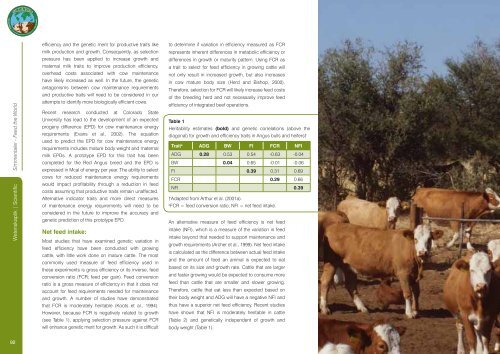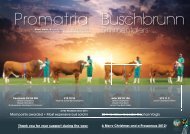Simmentaler Joernaal 2013.indb
Simmentaler Joernaal 2013.indb
Simmentaler Joernaal 2013.indb
You also want an ePaper? Increase the reach of your titles
YUMPU automatically turns print PDFs into web optimized ePapers that Google loves.
<strong>Simmentaler</strong> - Feed the World<br />
Wetenskaplik | Scientific<br />
92<br />
efficiency and the genetic merit for productive traits like<br />
milk production and growth. Consequently, as selection<br />
pressure has been applied to increase growth and<br />
maternal milk traits to improve production efficiency,<br />
overhead costs associated with cow maintenance<br />
have likely increased as well. In the future, the genetic<br />
antagonisms between cow maintenance requirements<br />
and productive traits will need to be considered in our<br />
attempts to identify more biologically efficient cows.<br />
Recent research conducted at Colorado State<br />
University has lead to the development of an expected<br />
progeny difference (EPD) for cow maintenance energy<br />
requirements (Evans et al., 2002). The equation<br />
used to predict the EPD for cow maintenance energy<br />
requirements includes mature body weight and maternal<br />
milk EPDs. A prototype EPD for this trait has been<br />
completed for the Red Angus breed and the EPD is<br />
expressed in Mcal of energy per year. The ability to select<br />
cows for reduced maintenance energy requirements<br />
would impact profitability through a reduction in feed<br />
costs assuming that productive traits remain unaffected.<br />
Alternative indicator traits and more direct measures<br />
of maintenance energy requirements will need to be<br />
considered in the future to improve the accuracy and<br />
genetic prediction of this prototype EPD.<br />
Net feed intake:<br />
Most studies that have examined genetic variation in<br />
feed efficiency have been conducted with growing<br />
cattle, with little work done on mature cattle. The most<br />
commonly used measure of feed efficiency used in<br />
these experiments is gross efficiency or its inverse, feed<br />
conversion ratio (FCR; feed per gain). Feed conversion<br />
ratio is a gross measure of efficiency in that it does not<br />
account for feed requirements needed for maintenance<br />
and growth. A number of studies have demonstrated<br />
that FCR is moderately heritable (Koots et al., 1994).<br />
However, because FCR is negatively related to growth<br />
(see Table 1), applying selection pressure against FCR<br />
will enhance genetic merit for growth. As such it is difficult<br />
to determine if variation in efficiency measured as FCR<br />
represents inherent differences in metabolic efficiency or<br />
differences in growth or maturity pattern. Using FCR as<br />
a trait to select for feed efficiency in growing cattle will<br />
not only result in increased growth, but also increases<br />
in cow mature body size (Herd and Bishop, 2000).<br />
Therefore, selection for FCR will likely increase feed costs<br />
of the breeding herd and not necessarily improve feed<br />
efficiency of integrated beef operations.<br />
Table 1<br />
Heritability estimates (bold) and genetic correlations (above the<br />
diagonal) for growth and efficiency traits in Angus bulls and heifers†<br />
Traita ADG BW FI FCR NFI<br />
ADG 0.28 0.53 0.54 -0.63 -0.04<br />
BW 0.04 0.65 -0.01 -0.06<br />
FI 0.39 0.31 0.69<br />
FCR 0.29 0.66<br />
NFI 0.39<br />
†Adapted from Arthur et al. (2001a).<br />
aFCR = feed conversion ratio; NFI = net feed intake.<br />
An alternative measure of feed efficiency is net feed<br />
intake (NFI), which is a measure of the variation in feed<br />
intake beyond that needed to support maintenance and<br />
growth requirements (Archer et al., 1999). Net feed intake<br />
is calculated as the difference between actual feed intake<br />
and the amount of feed an animal is expected to eat<br />
based on its size and growth rate. Cattle that are larger<br />
and faster growing would be expected to consume more<br />
feed than cattle that are smaller and slower growing.<br />
Therefore, cattle that eat less than expected based on<br />
their body weight and ADG will have a negative NFI and<br />
thus have a superior net feed efficiency. Recent studies<br />
have shown that NFI is moderately heritable in cattle<br />
(Table 2) and genetically independent of growth and<br />
body weight (Table 1).



